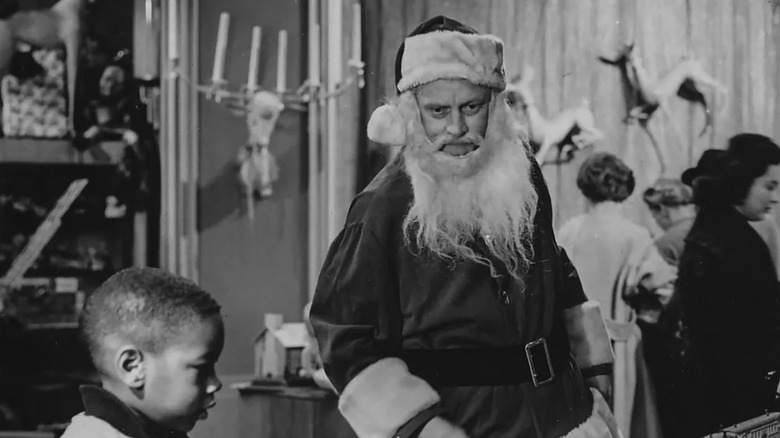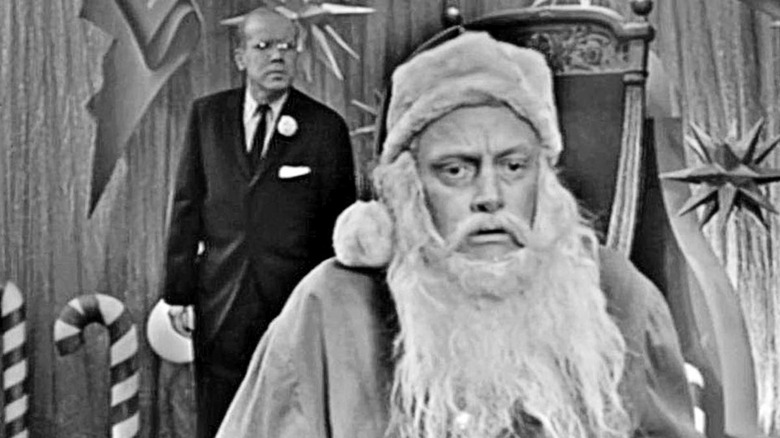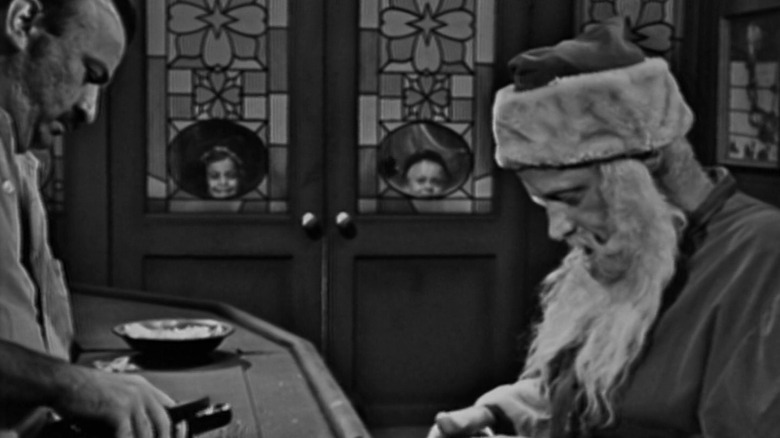A Sweet Twilight Zone Episode About Santa Still Somehow Managed To Cause Controversy
It's probably the fault of closed-minded, conservative propaganda that the idea of subversiveness within art received a bad reputation. Just as all art is political, all art is (or at least can be) a little subversive. Certainly the dictionary definition of the term, where a work of art intends to undermine the power and/or authority of an established idea, system or value, is heavily akin to the way plot structure tends to be broken down within plays and screenplays: a period of Stasis being interrupted by an Intrusion or Inciting Action, and so on.
Given how weird a number of people are when it comes to the behavior and attitudes toward the Christmas holiday, it's no real surprise that any art having to do with Christmas tends toward subversion. This can manifest in tangential ways (like the slapstick violence of the "Home Alone" series) or direct ways (Santa Claus himself kicking ass in "Violent Night"), but most subversion within Christmas movies and television is used in that dramatic structure fashion, where the values of Christmas are typically not left broken and discarded but rather are reinforced and made whole.
One of the most beloved (and subversive) Christmas movies, Frank Capra's "It's a Wonderful Life," plays in retrospect like almost a proof-of-concept reel for Rod Serling's "The Twilight Zone" series. Thus, when Serling eventually got around to making his own Christmas-themed episode during the show's second season, entitled "Night of the Meek," he, director Jack Smight, and star Art Carney ended up with a sweet, lovely Capra-esque holiday tale. However, the mere involvement of Christmas meant that someone had a complaint, an issue that demonstrates that this person was (like many of their ilk) not great at reading media.
'Night of the Meek' is a perfect marriage of actor and character
In the case of "Night of the Meek," Serling wasn't initially inspired by Capra or any particular high concept, but rather became excited at the marriage of actor and character that he dreamed up. According to producer Buck Houghton, as quoted in Marc Scott Zicree's "The Twilight Zone Companion":
"Once in a while, Rod would have an enthusiasm. He'd say to himself or to me or to Carol [Serling] or whomever, that he particularly liked somebody. There was a Christmas show that we did just because he wanted to see Art Carney play Santa Claus."
Carney, most famous for playing Ed Norton on "The Honeymooners," plays in "Night of the Meek" a man named Henry Corwin (as Zicree points out, the name references one of Serling's idols, writer Norman Corwin). A department store Santa who lives in a very low-income area of (presumably) New York City, Corwin is initially as emotionally destitute as Jimmy Stewart's George Bailey in "Wonderful Life," having resorted to drinking in order to deal with the pain of not being able to help out his friends and others in need during the Christmas season.
The episode allows Carney to demonstrate his considerable dramatic chops (crying on camera, playing a depressed drunk, et al) as well as use his well-known gift for comedy; when Corwin stumbles upon a magic sack in the street after being fired from his job, he finds that it acts like the real Santa's sack, providing whatever gifts and various objects that people wish for or need. With co-stars like John Fiedler (as Corwin's stuffy boss) and Burt Mustin (as a cheerful homeless man), Carney makes "Night of the Meek" as magical and delightful as Serling hoped.
A complaint that misses the point
According to Zicree, the magic created by "Night of the Meek" was actually palpable to those on set while it was being shot. Being one of the six episodes of the second season shot on video instead of film, some extras (especially children) could get a little rowdy while shooting video. Yet, as production assistant Lillian Gallo describes, that wasn't the case on this episode:
"There were more children performing on that show as extras than on the other tape shows, and I remember their excitement and their joy. Sometimes, it was difficult for them to contain themselves during the times that you have to be quiet during the show. There was a different atmosphere throughout that shooting schedule."
Sadly, the spirit of Christmas did not translate to every viewer of the show as it apparently did to everyone on set. As Zicree recounts, one audience member was so offended at the portrayal of Santa Claus as a drunk (calling it "blasphemy") that he fired off angry letters to a number of newspapers, CBS, and Serling himself.
What this fool failed to realize is that "Night of the Meek" isn't about blaspheming the name of Santa Claus (who, it must be said, is not necessarily a religious figure) but is instead about reinforcing the themes of charity, love, understanding, and kindness that Santa represents. The aspect of Corwin being drunk only allows such themes to be more relatable, less cloying; in a word, more human. It just goes to show that viewers — and anyone else seeking to stir up similar controversy about art — would do well to keep those values in mind.


